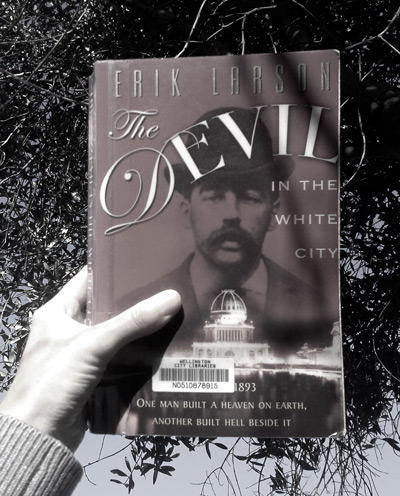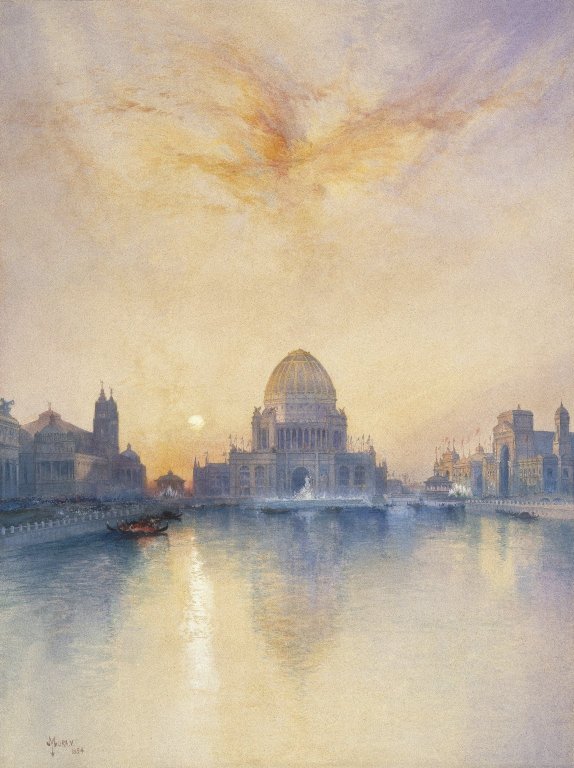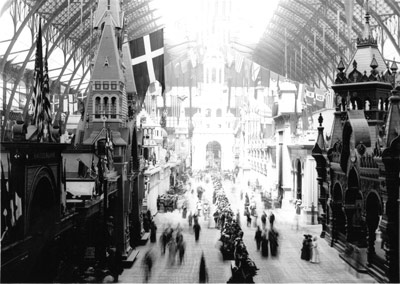The Devil in the White City: Book Review
by amy – September 21, 2015 in Words

Beneath the gore and smoke and loam, this book is about the evanescence of life, and why some men choose to fill their brief allotment of time engaging the impossible, others in the manufacture of sorrow. In the end it is a story of the ineluctable conflict between good and evil, daylight and darkness, the White City and the Black.
Erik Larson’s prologue well captures the spirit of this tale. His words are a better introduction than I could hope to write in order to inspire any would-be readers. Though it reads like a novel, this is a book of history that immerses the reader in a time and place long forgotten. It tells in parallel the biography of two fascinating, ambitious, and clever men: the architect Daniel Burnham and a psychopathic killer who went by the alias H. H. Holmes, among many others.
The author clarifies straight away that this is not a book of fiction. Anything appearing between quotation marks comes from an original letter or document. The bibliography is extensive, indicating that this book probably required years of research. He goes into some detail in the epilogue about his in-depth search for original sources. It’s worthwhile to acknowledge Larson’s devotion to the facts, because the story told is one that amazes and confounds.
While the chapters on Holmes are more luridly magnetizing, Burnham’s rags-to-riches story is also compelling, and plays a fundamental role in setting up the context in which the story unfolds. Through Burnham’s rise to fame among Chicago’s leading businessmen, one learns how the city operated in the late 19th century, and what the climate was, in many senses of the word. One discovers how Chicago was developing economically and socially as one of America’s burgeoning centers, how it was engaged in a bitter rivalry with New York, how it yearned for cultural recognition, and how social and labor movements clashed with industry as the city struggled to move forward. I enjoyed the portrait Larson draws of Chicago as a city that was destroying itself in the midst of its own awakening. The fact that Larson didn’t grow up in Chicago, or even know much about it prior to researching this book, seems to have aided his unbiased depiction of its raw nature, its complicated debate.

Chicago World’s Fair by Thomas Moran, 1894. Brooklyn Museum [Public Domain] via Wikipedia Commons.

The exhibit hall inside the Manufactures and Liberal Arts Building in Chicago. Photograph by Hemming Hultgren’s grandfather via Wikipedia Commons.
This book gleams with allure through the smoky atmosphere of a long-lost century, drawing a colorful picture of the ‘Black City,’ as Chicago was known, with its cigars, its railroads, its industry, its trash-filled alleys, its brothels, its celebrities, its gilded horse-drawn carriages of the elite. It describes the beauty of Lake Michigan, and the storms it unleashes. It uncovers what prefers to stay hidden in the shadows. It’s about deals made behind closed doors, unrequited desires, and the private anxieties of high society men and women. It looks closely into the face of insanity, and the disturbance in the human brain that can lead one to kill for no explicable reason, or for pleasure.
As much as the book explores the underbelly of Chicago, it also soars to its heights through the success of its great architects, and the industrial optimism they renewed in Americans by building the extraordinary ‘White City’, an architectural accomplishment of a kind never before seen on Earth.
The World’s Fair was a legendary event. The 14 colossal buildings in the Court of Honor were an astounding achievement in themselves. They were designed and built in just two years, along with nearly 200 other temporary buildings covering 600 acres. It was for this event that the first Ferris Wheel was invented, born out of the need for something to rival the Eiffel Tower and its looming testimony to the superiority of French engineering. The Fair was open for 6 months and attracted 27 million visitors. It was bigger than any other World’s Fair in history. When the Fair ended, all the buildings were destroyed. All we have left are old photographs and paintings to recreate that incredible event.
Larson’s book details the many obstacles and hardships the Fair’s creators faced, among them an economic recession, a cholera pandemic, and some of the worst storms in Chicago’s history. Many of the men suffered from seriously debilitating health problems, some fatal.
Back on the ground during this event, the reader is amazed by the ease with which Holmes cons everyone, including his creditors and his wives. His prowess at manipulating compassion, trust and faith is deeply unsettling. The man was endowed with a charisma that is breathtaking and terrifying when one knows he was concealing a total lack of compassion for human life. Larson provides a captivating account of how Holmes constructs an empire of death and deceit under the facade of various business fronts, which sprawls to encompass a whole city block. He lures and kills his victims there, including several of his wives, just blocks from where Burnham spearheads the gargantuan project of designing and building the World Fair.
For the full effect, it’s recommended to read this book late in the evening in the company of dripping candles and some good, strong wine. This little window into American history is a fascinating one.
